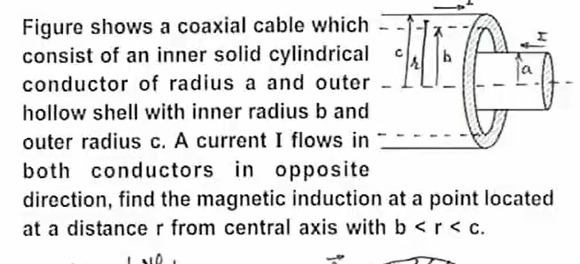Question
Question: Figure shows a coaxial cable which consist of an inner solid cylindrical conductor of radius a and o...
Figure shows a coaxial cable which consist of an inner solid cylindrical conductor of radius a and outer hollow shell with inner radius b and outer radius c. A current I flows in both conductors in opposite direction, find the magnetic induction at a point located at a distance r from central axis with b < r < c.

The magnetic induction at a point located at a distance r from the central axis with b < r < c is: B=2πrμ0I(c2−b2c2−r2)
The magnetic induction at a point located at a distance r from the central axis with b < r < c is: B=2πrμ0I(c2−b2r2−b2)
The magnetic induction at a point located at a distance r from the central axis with b < r < c is: B=2πrμ0I
The magnetic induction at a point located at a distance r from the central axis with b < r < c is: B=2πrμ0I(a2c2−r2)
The magnetic induction at a point located at a distance r from the central axis with b < r < c is: B=2πrμ0I(c2−b2c2−r2)
Solution
To find the magnetic induction at a distance r from the central axis, where b<r<c, we use Ampere's Law. We consider a circular Amperian loop of radius r concentric with the axis of the coaxial cable. Due to symmetry, the magnetic field B is tangential to this loop and has a constant magnitude B.
Ampere's Law states: ∮B⋅dl=μ0Ienc The left side of the equation for our Amperian loop is: ∮B⋅dl=B⋅(2πr) Now we need to find the total current enclosed by the Amperian loop, Ienc. The inner conductor carries a current I. Let's assume this current is in the positive z-direction. The outer hollow shell carries an equal current I in the opposite direction (negative z-direction).
Since the Amperian loop is at a distance r such that b<r<c, it encloses:
- The entire inner conductor of radius a. The current enclosed from the inner conductor is I.
- A portion of the outer hollow shell. The outer shell has current distributed uniformly over its cross-sectional area, which is from radius b to c. The total current in this shell is I in the opposite direction. The current density in the outer shell is Jouter=π(c2−b2)I.
The Amperian loop of radius r encloses the part of the outer shell from radius b to radius r. The area of this portion of the shell is πr2−πb2. The current flowing through this area in the outer shell is: Ienclosed_outer=Jouter×(πr2−πb2)=π(c2−b2)I×π(r2−b2)=Ic2−b2r2−b2 Since this current is in the opposite direction to the current in the inner conductor, we subtract it from the current of the inner conductor to find the net enclosed current in the positive z-direction: Ienc=Iinner−Ienclosed_outer=I−Ic2−b2r2−b2 Ienc=I(1−c2−b2r2−b2)=I(c2−b2(c2−b2)−(r2−b2)) Ienc=I(c2−b2c2−b2−r2+b2)=Ic2−b2c2−r2 Now, applying Ampere's Law: B(2πr)=μ0Ienc B(2πr)=μ0Ic2−b2c2−r2 Solving for B: B=2πrμ0Ic2−b2c2−r2
